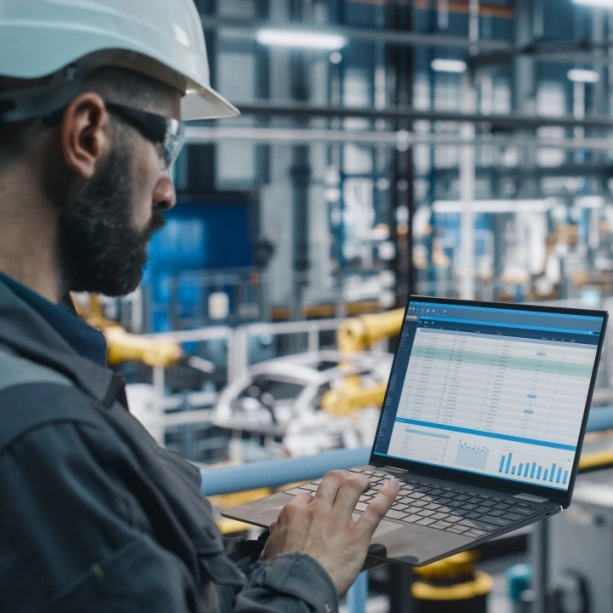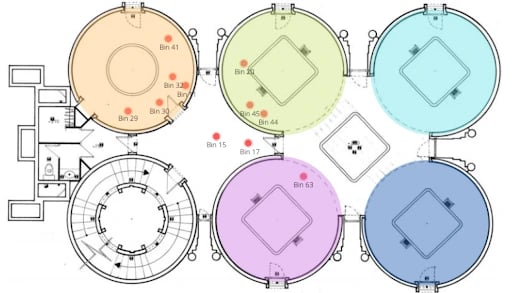Companies and employees alike are continuously searching for ways to improve workplace processes. Process improvements, such as Work in Process (WIP) tracking, have become more necessary – especially within the manufacturing sector. The hunt for higher yields, less downtime, and fewer accidents is a cycle of continuous improvement. Let’s explore three ways manufacturing processes can be improved through the combination of WIP and Real Time Location Systems (RTLS).
This diagram is a visual representation of materials (red, numbered bins) throughout a manufacturing plant. Identifying the location of them through RTLS streamlines WIP tracking.
What is Work in Process (WIP) Tracking?
Before we dive into how RTLS and WIP work hand in hand, let’s take a step back to understand what the term means. Work In Process (WIP) are partially completed goods. Such goods or materials are defined as products that move from raw materials to finished products in a short period. In the manufacturing world, this could mean materials that move through assembling units, lathing components, biologics preparement, textile treatment, and many other manufacturing processes.
Work In Process is often confused with work in progress. Work in progress, also referred to as WIP, is a term used in supply chain management to describe the costs of unfinished goods in the manufacturing process. These costs include raw materials, labor, and overhead costs.
What are Real Time Location Systems (RTLS)?
Whether you are an inventory manager or facility director, having visibility of all your assets is necessary for a productive and compliant manufacturing plant. Although the most common technology used for managing inventory is Radio-Frequency Identification (RFID), both Active and Passive RFID provide limited visibility as location is based on the last transmitted location. With Real-Time Location Systems (RTLS), visibility becomes continuous, and location accuracy can range anywhere from meters to centimeters depending on the technology. RTLS can provide value in dozens of use cases in manufacturing, but the focus of this article will be on examples of WIP tracking.
Zone-Based Tracking
The process of raw materials making their way through a manufacturing plant can be formulaic and linear. It’s common to have work orders move in tandem with the components allowing workers to scan barcodes at each station. This method makes it simple to mark unfinished products. However, this system requires manual effort and opens the door to human error and negligence.
A simple way RTLS can provide value for workstations is by dividing manufacturing facilities into zones. This system allows managers and directors to see how many pieces are in each zone, how long they stay in each zone, and where to find bottlenecks. With Real-Time Location Systems (RTLS), manually scanning an item and updating a spreadsheet is no longer necessary. Reliable and real-time location data helps eliminate production delays.
Increase Your ROI by Investing in AirFinder OnSite
- Low Cost. AirFinder OnSite XLE is a fraction of the cost of competitors' pricing.
- Long Battery Life. XLE lasts up to 7 years with hundreds of location updates daily.
- Increased Efficiency. Spend less time looking for assets, and more time being productive.
Made-to-Order Production
Manufacturing plants can sometimes be laid out in a confusing manner, adding to material loss and production delays. Let’s use an apparel manufacturing plant as an example. In a linear layout the process would flow like so:
overlock stitching > double-needle stitching > trimming > packing
That said, sometimes factories have spatial constraints that force workstations to be out of order:
double-needle stitching > packing > overlock stitching > trimming
With nonlinear layouts, workers spend more time moving materials than working on them. This can lead to costly setbacks.
Let’s look at a more complicated example such as Made-to-Order (MTO) production in discrete manufacturing. In an MTO process, products flow through many different workstations. However, one workstation might need tools A, B, and C, and the next station needs A, C, and D. This makes current location data extremely valuable. Since most MTO layouts are customized, WIP tracking can be difficult.
One might argue that the solution is to rearrange the workstations and build a linear process, which is easier said than done. Most nonlinear layouts happen due to spatial constraints. Rearranging workstations would require building or buying a different manufacturing plant. This means that RTLS has the potential to provide even more value.
Batch Manufacturing
Perhaps one of the most economical methods of manufacturing is batch manufacturing. This method usually refers to a process where many identical components are put through production simultaneously. At each stage, all the parts in the batch advance together instead of individually. Imagine trying to manage 1,000 identical metal parts. Batch manufacturing simplifies this headache by tracking the movement of a bin of metal parts from workstation to workstation. This system does not only apply to bins. Batch manufacturing works for any physical container such as a cart, tray, or pallet.
RTLS can provide value to products that have a set shelf-life. Mitigating integrity loss is simple when batches are flagged if held too long or left outside of an acceptable time frame. RTLS can also provide alerts if a process begins prematurely for products that need a set interval for cooling or drying.
Closing Thoughts on RTLS for WIP Tracking
Asset tracking systems or RTLS are ideal solutions for manufacturing processes involving WIP. The bottom line is RIO. When a system provides time-saving moments, material recovery, and improved production, is it worth the investment? The answer is yes. Even if your manufacturing facility only saves a single minute per hour, that can add up to millions of dollars in savings.
When factories save time, they can finish more projects, prevent waste, and generate more revenue. If you would like to see how RTLS could be incorporated into your WIP, contact Link Labs for a demo.






